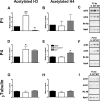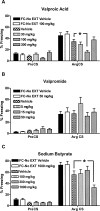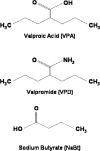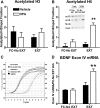Histone modifications around individual BDNF gene promoters in prefrontal cortex are associated with extinction of conditioned fear
- PMID: 17522015
- PMCID: PMC2216532
- DOI: 10.1101/lm.500907
Histone modifications around individual BDNF gene promoters in prefrontal cortex are associated with extinction of conditioned fear
Abstract
Extinction of conditioned fear is an important model both of inhibitory learning and of behavior therapy for human anxiety disorders. Like other forms of learning, extinction learning is long-lasting and depends on regulated gene expression. Epigenetic mechanisms make an important contribution to persistent changes in gene expression; therefore, in these studies, we have investigated whether epigenetic regulation of gene expression contributes to fear extinction. Since brain-derived neurotrophic factor (BDNF) is crucial for synaptic plasticity and for the maintenance of long-term memory, we examined histone modifications around two BDNF gene promoters after extinction of cued fear, as potential targets of learning-induced epigenetic regulation of gene expression. Valproic acid (VPA), used for some time as an anticonvulsant and a mood stabilizer, modulates the expression of BDNF, and is a histone deacetylase (HDAC) inhibitor. Here, we report that extinction of conditioned fear is accompanied by a significant increase in histone H4 acetylation around the BDNF P4 gene promoter and increases in BDNF exon I and IV mRNA expression in prefrontal cortex, that VPA enhances long-term memory for extinction because of its HDAC inhibitor effects, and that VPA potentiates the effect of weak extinction training on histone H4 acetylation around both the BDNF P1 and P4 gene promoters and on BDNF exon IV mRNA expression. These results suggest a relationship between histone H4 modification, epigenetic regulation of BDNF gene expression, and long-term memory for extinction of conditioned fear. In addition, they suggest that HDAC inhibitors may become a useful pharmacological adjunct to psychotherapy for human anxiety disorders.
Figures






Similar articles
-
The histone deacetylase inhibitor valproic acid enhances acquisition, extinction, and reconsolidation of conditioned fear.Learn Mem. 2008 Jan 3;15(1):39-45. doi: 10.1101/lm.801108. Print 2008 Jan. Learn Mem. 2008. PMID: 18174372 Free PMC article.
-
Epigenetic regulation of reelin and brain-derived neurotrophic factor genes in long-term potentiation in rat medial prefrontal cortex.Neurobiol Learn Mem. 2012 May;97(4):425-40. doi: 10.1016/j.nlm.2012.03.007. Epub 2012 Mar 24. Neurobiol Learn Mem. 2012. PMID: 22469747
-
Enhanced hippocampal BDNF/TrkB signaling in response to fear conditioning in an animal model of posttraumatic stress disorder.J Psychiatr Res. 2011 Apr;45(4):460-8. doi: 10.1016/j.jpsychires.2010.08.009. Epub 2010 Sep 21. J Psychiatr Res. 2011. PMID: 20863519
-
The use of cognitive enhancers in animal models of fear extinction.Pharmacol Biochem Behav. 2011 Aug;99(2):217-28. doi: 10.1016/j.pbb.2011.01.009. Epub 2011 Jan 20. Pharmacol Biochem Behav. 2011. PMID: 21256147 Review.
-
Epigenetic landscape of amphetamine and methamphetamine addiction in rodents.Epigenetics. 2015;10(7):574-80. doi: 10.1080/15592294.2015.1055441. Epigenetics. 2015. PMID: 26023847 Free PMC article. Review.
Cited by
-
The brain-derived neurotrophic factor Val66Met polymorphism predicts response to exposure therapy in posttraumatic stress disorder.Biol Psychiatry. 2013 Jun 1;73(11):1059-63. doi: 10.1016/j.biopsych.2012.10.033. Epub 2013 Jan 8. Biol Psychiatry. 2013. PMID: 23312562 Free PMC article. Clinical Trial.
-
CBP-Dependent memory consolidation in the prefrontal cortex supports object-location learning.Hippocampus. 2015 Dec;25(12):1532-40. doi: 10.1002/hipo.22473. Epub 2015 Jun 2. Hippocampus. 2015. PMID: 25941038 Free PMC article.
-
Molecularly Defined Hippocampal Inputs Regulate Population Dynamics in the Prelimbic Cortex to Suppress Context Fear Memory Retrieval.Biol Psychiatry. 2020 Oct 1;88(7):554-565. doi: 10.1016/j.biopsych.2020.04.014. Epub 2020 Apr 28. Biol Psychiatry. 2020. PMID: 32560963 Free PMC article.
-
Activity-dependent plasticity and gene expression modifications in the adult CNS.Front Mol Neurosci. 2011 Nov 28;4:50. doi: 10.3389/fnmol.2011.00050. eCollection 2011. Front Mol Neurosci. 2011. PMID: 22144945 Free PMC article.
-
Effect of HDAC inhibitors on neuroprotection and neurite outgrowth in primary rat cortical neurons following ischemic insult.Neurochem Res. 2013 Sep;38(9):1921-34. doi: 10.1007/s11064-013-1098-9. Epub 2013 Jun 22. Neurochem Res. 2013. PMID: 23793904
References
-
- Barad M., Blouin A.M., Cain C.K. Like extinction, latent inhibition of conditioned fear in mice is blocked by systemic inhibition of L-type voltage-gated calcium channels. Learn. Mem. 2005;11:536–539. - PubMed
-
- Baum M. Spontaneous recovery from the effects of flooding (exposure) in animals. Behav. Res. Ther. 1988;26:185–186. - PubMed
-
- Berman D.E., Dudai Y. Memory extinction, learning anew, and learning the new: Dissociations in the molecular machinery of learning in cortex. Science. 2001;291:2417–2419. - PubMed
-
- Bouton M.E., King D.A. Contextual control of the extinction of conditioned fear: Tests for the associative value of the context. J. Exp. Psychol. Anim. Behav. Process. 1983;9:248–265. - PubMed
-
- Cain C.K., Blouin A.M., Barad M. Temporally massed CS presentations generate more fear extinction than spaced presentations. J. Exp. Psychol. Anim. Behav. Process. 2003;29:323–333. - PubMed
Publication types
MeSH terms
Substances
LinkOut - more resources
Full Text Sources
Other Literature Sources
